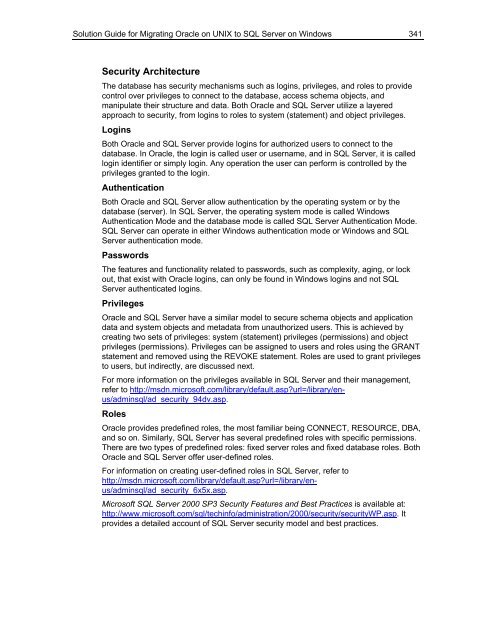Solution Guide for Migrating Oracle on UNIX to SQL Server - Willy .Net
Solution Guide for Migrating Oracle on UNIX to SQL Server - Willy .Net
Solution Guide for Migrating Oracle on UNIX to SQL Server - Willy .Net
- No tags were found...
Create successful ePaper yourself
Turn your PDF publications into a flip-book with our unique Google optimized e-Paper software.
<str<strong>on</strong>g>Soluti<strong>on</strong></str<strong>on</strong>g> <str<strong>on</strong>g>Guide</str<strong>on</strong>g> <str<strong>on</strong>g>for</str<strong>on</strong>g> <str<strong>on</strong>g>Migrating</str<strong>on</strong>g> <str<strong>on</strong>g>Oracle</str<strong>on</strong>g> <strong>on</strong> <strong>UNIX</strong> <strong>to</strong> <strong>SQL</strong> <strong>Server</strong> <strong>on</strong> Windows 341Security ArchitectureThe database has security mechanisms such as logins, privileges, and roles <strong>to</strong> providec<strong>on</strong>trol over privileges <strong>to</strong> c<strong>on</strong>nect <strong>to</strong> the database, access schema objects, andmanipulate their structure and data. Both <str<strong>on</strong>g>Oracle</str<strong>on</strong>g> and <strong>SQL</strong> <strong>Server</strong> utilize a layeredapp roach <strong>to</strong> security, from logins <strong>to</strong> roles <strong>to</strong> system (statement) and object privileges.LoginsBoth <str<strong>on</strong>g>Oracle</str<strong>on</strong>g> and <strong>SQL</strong> <strong>Server</strong> provide logins <str<strong>on</strong>g>for</str<strong>on</strong>g> authorized users <strong>to</strong> c<strong>on</strong>nect <strong>to</strong> thedatabase. In <str<strong>on</strong>g>Oracle</str<strong>on</strong>g>, the login is called user or username, and in <strong>SQL</strong> <strong>Server</strong>, it is calledlogin identifier or simply login. Any operati<strong>on</strong> the user can per<str<strong>on</strong>g>for</str<strong>on</strong>g>m is c<strong>on</strong>trolled by theprivileges granted <strong>to</strong> the login.Authenticati<strong>on</strong>Both <str<strong>on</strong>g>Oracle</str<strong>on</strong>g> and <strong>SQL</strong> <strong>Server</strong> allow authenticati<strong>on</strong> by the operating system or by thedatabase (server). In <strong>SQL</strong> <strong>Server</strong>, the operating system mode is called WindowsAuthenticati<strong>on</strong> Mode and the database mode is called <strong>SQL</strong> <strong>Server</strong> Authenticati<strong>on</strong> Mode.<strong>SQL</strong> <strong>Server</strong> can operate in either Windows authenticati<strong>on</strong> mode or Windows and <strong>SQL</strong><strong>Server</strong> authenticati<strong>on</strong> mode.PasswordsThe features and functi<strong>on</strong>ality related <strong>to</strong> passwords, such as complexity, aging, or lockout, that exist with <str<strong>on</strong>g>Oracle</str<strong>on</strong>g> logins, can <strong>on</strong>ly be found in Windows logins and not <strong>SQL</strong><strong>Server</strong> authenticated logins.Privileges<str<strong>on</strong>g>Oracle</str<strong>on</strong>g> and <strong>SQL</strong> <strong>Server</strong> have a similar model <strong>to</strong> secure schema objects and applicati<strong>on</strong>data and system objects and metadata from unauthorized users. This is achieved bycreating two sets of privileges: system (statement) privileges (permissi<strong>on</strong>s) and objectprivileges (permissi<strong>on</strong>s). Privileges can be assigned <strong>to</strong> users and roles using the GRANTstatement and removed using the REVOKE statement. Roles are used <strong>to</strong> grant privileges<strong>to</strong> users, but indirectly, are discussed next.Roles<str<strong>on</strong>g>Oracle</str<strong>on</strong>g> provides predefined roles, the most familiar being CONNECT, RESOURCE, DBA,and so <strong>on</strong>. Similarly, <strong>SQL</strong> <strong>Server</strong> has several predefined roles with specific permissi<strong>on</strong>s.There are two types of predefined roles: fixed server roles and fixed database roles. Both<str<strong>on</strong>g>Oracle</str<strong>on</strong>g> and <strong>SQL</strong> <strong>Server</strong> offer user-defined roles.For more in<str<strong>on</strong>g>for</str<strong>on</strong>g>mati<strong>on</strong> <strong>on</strong> the privileges available in <strong>SQL</strong> <strong>Server</strong> and their management,refer <strong>to</strong> http://msdn.microsoft.com/library/default.asp?url=/library/enus/adminsql/ad_security_94dv.asp.For in<str<strong>on</strong>g>for</str<strong>on</strong>g>mati<strong>on</strong> <strong>on</strong> creating user-defined roles in <strong>SQL</strong> <strong>Server</strong>, refer <strong>to</strong>http://msdn.microsoft.com/library/default.asp?url=/library/enus/adminsql/ad_security_6x5x.asp.Microsoft <strong>SQL</strong> <strong>Server</strong> 2000 SP3 Security Features and Best Practices is available at:http://www.microsoft.com/sql/techinfo/administrati<strong>on</strong>/2000/security/securityWP.asp. Itprovides a detailed account of <strong>SQL</strong> <strong>Server</strong> security model and best practices.
















